What Are Niçoise Olives And The Best Ways To Use Them?
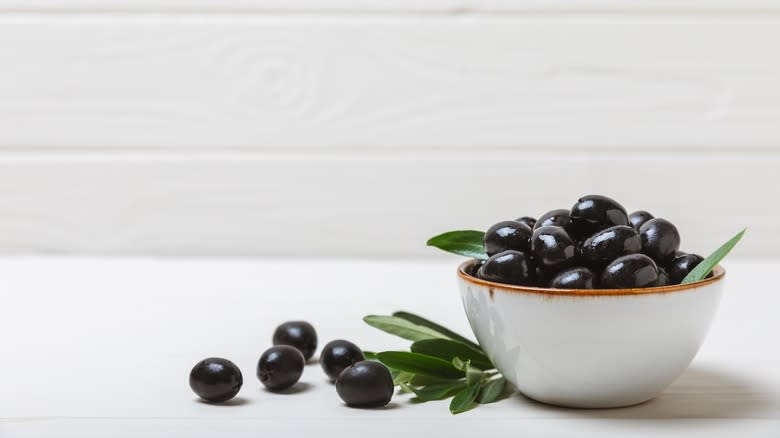
Olives have flourished in the South of France for over 2,000 years, and today there still exist fruit-bearing olive trees in this Mediterranean region of the country that are many hundreds of years old. Olives in general have a long history in traditional cuisine from southern France, but Niçoise olives in particular reflect deep-rooted culinary traditions in both their flavor and the manner in which they're harvested.
Niçoise olives are a well-preserved culinary legacy, as they continue to be harvested using traditional methods that do not differ greatly from the way they were produced centuries ago. Because these olives are so closely linked with their place of origin, this overview of Niçoise olives uses resources from local French culinary organizations that protect the authenticity of this ancient and beloved ingredient. Further insight comes from authoritative French culinary texts, like the Dictionnaire Larousse Gastronomique (culinary encyclopedia). Niçoise olives are a representative example of local and regional agriculture, and as such, it's regional French texts that best describe what defines Niçoise olives and how they are made.
Read more: French Cooking Tricks You Need In Your Life
What Are Niçoise Olives?
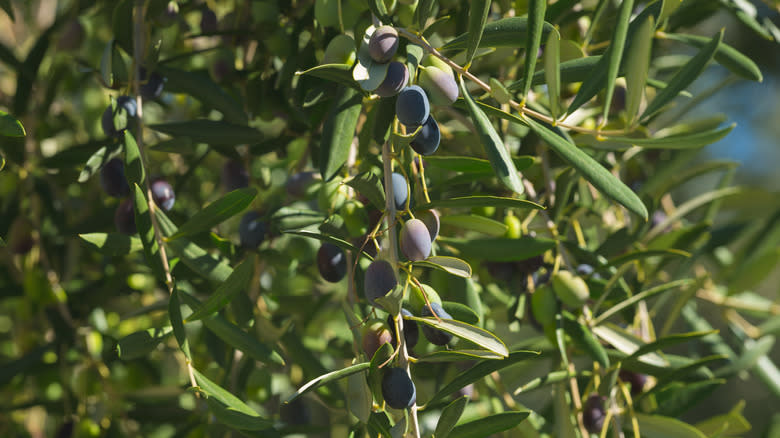
Niçoise olives come from a specific variety of olive tree, the Cailletier. This cultivar grows in the Alps Maritimes department of France, in the region of Provence located in the southeastern corner of the country, which shares a border with Italy and has a Mediterranean climate. These same trees are also plentiful across the Italian border, where their olives are known as Taggiasca, but they have reached global renown with the Niçoise moniker, taking the name from Nice, the capital city of the French region, which produces a large number of these olives.
True Niçoise olives, also known as olive noire de Nice, Nice black olives, and Pendoulier, are a Product of Designated Origin (PDO) in Europe. This means they're tied to a geographic region (in this case, the Alpes-Maritimes) and are produced using traditional harvesting and preservation techniques. Much like how true French Champagne only comes from the region of Champagne, true Niçoise olives come from the greater Nice area. While many varieties of olives are available under the name of "Niçoise style," these are not true Niçoise olives and typically do not meet the same standard of quality.
There's a historic precedent for the quality of Niçoise olives. As early as the mid-1700s, their reputation for quality was already in print and was featured in the L'Encyclopédie de Diderot et d'Alembert, an Enlightenment-era French encyclopedia.
How Are Niçoise Olives Made?
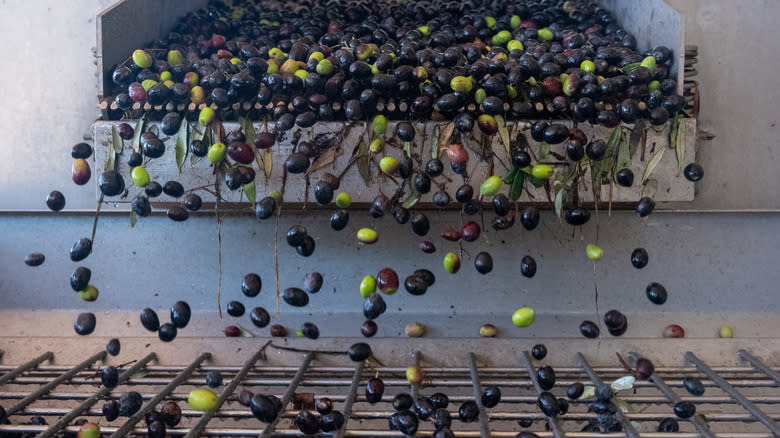
Niçoise olives are a variety of black olive, which means they aren't harvested until they've reached full maturity; the difference between black and green olives, essentially, is that green ones are picked before they're fully ripe. Harvesting black olives occurs in France between January and April, and the traditional method entails shaking olives to gather them into nets spread below the trees.
After harvesting (and within 24 hours of being picked from the trees) Niçoise olives are soaked in a simple brine that consists only of water and sea salt, so as not to overpower the olives' natural flavor. They're left to marinate in this brine for three months. Although they're classified as black, Niçoise olives can vary in color. Most are the signature purple-hued black, but some can be closer to red or even light green. In many cases, only the darkest ones are packed in jars for distribution.
What Do Niçoise Olives Taste Like?
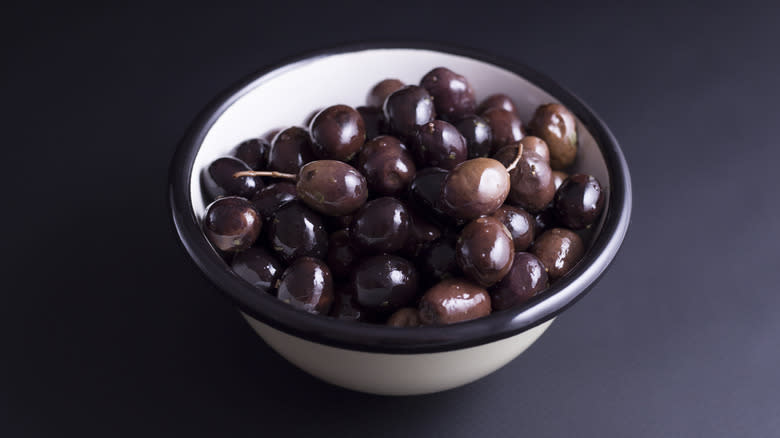
Like most varieties, Niçoise olives are too bitter to be consumed raw, so they're cured in a simple salt brine to preserve the olives while allowing their natural flavor to come through. Due to the brine, Niçoise olives are inherently salty and savory, but their flavor is more complex than mere brininess. According to the Syndicat Interprofessionnel de l'Olive de Nice (SION), a French organization that defends the authenticity of Niçoise PDO olives, true Niçoise olives have a little fruitiness. The flavor of these olives suggests hints of prune and cherry, maintaining a slight bitterness without being particularly sharp or acidic.
The Niçoise olive's taste comes in contrast with the olive's aroma, which the SION further describes in sommelier fashion as having the smell "of old wines [and] of leather." The bitterness in this fruit-forward flavor profile pairs well with the peppery, lemony, garlicky flavors of Mediterranean cuisine, but these olives are mild and mellow enough to be enjoyed on their own.
Niçoise Olives Vs. Olive Oil
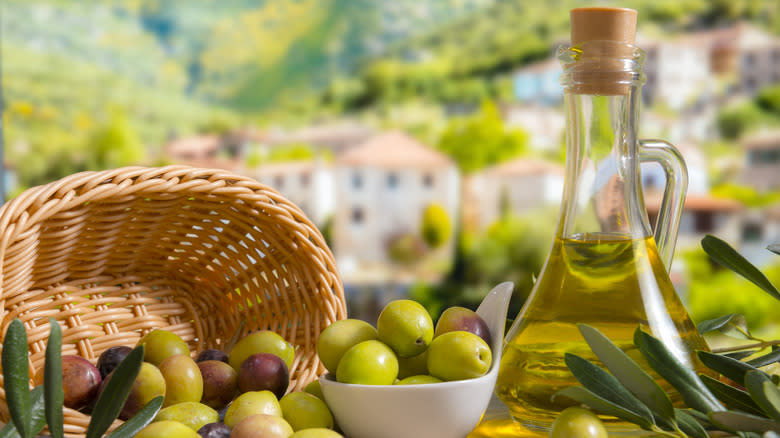
While Niçoise olives are common table olives, this same variety from the cailletier tree is also used to make olive oil, a practice with ancient origins. Niçoise olives bound to become oil are also harvested once they've reached peak maturity. These olives are processed in a mill where they are crushed in order to extract their oil. There are still a handful of mills in the greater Nice region that continue to operate under the "Genoese system," using the centuries-old technology of wooden gears powered by a water wheel.
Nice olive oil, in order to achieve the same PDO certification as the Nice table olive, cannot be extracted from olive paste at a temperature above 80 degrees Fahrenheit. This ensures that the oil maintains its rich natural flavor, which SION describes as having a "wide aromatic range" with a "main aroma of almond, and secondary flavors of raw artichoke, broom flowers, hay, grass, leaves, dried fruits, pastry, ripe apple or lemon." While good for cooking, Nice olive oil's natural flavors are best enjoyed when unheated and drizzled over salads, or even on top of warm dishes before they're served.
They Are Integral To The Niçoise Salad
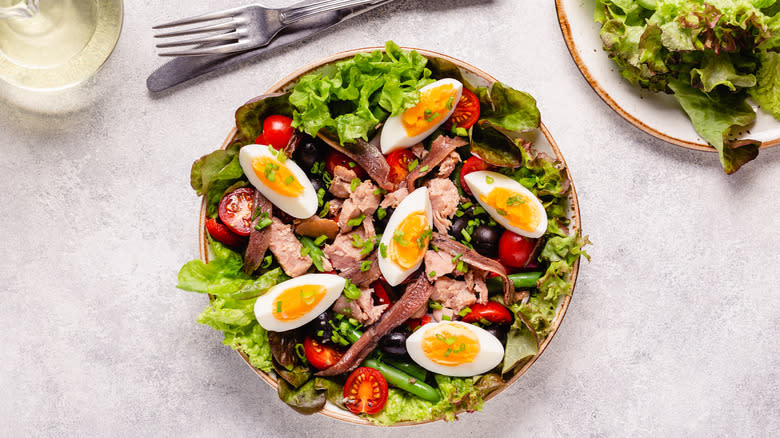
Niçoise olives are best known and most often used in a renowned regional dish, the Niçoise salad, one of the more popular dishes in Nice to reach international acclaim. Though this salad has contentious origins, it's esteemed as a cornerstone of Niçoise cuisine, and the locals have a very specific idea of the ingredients and methodology that goes into preparing it.
In fact, Nice has a culinary organization that enforces the authenticity of Niçoise cuisine. Known as the Cercle de la Capelina d'Or, this culinary police force ensures that restaurants are serving authentic local fare that preserves Nice's culinary history. On their site, they include the most authentic recipes for traditional Niçoise dishes, which have been compiled from representative cookbooks and historic home recipes. The most traditional version of the Niçoise salad calls for tomatoes, hard-boiled eggs, tuna, anchovies, basil, and the black olives of Nice. In including a recipe for a true "salade Niçoise" on the organization's official website, the Cercle de la Capelina d'Or states specifically that the salad must be made with Niçoise olives. While other recipes around the world may vary slightly in their ingredients and contradict the true recipe, olives are always a must.
How To Cook With Niçoise Olives
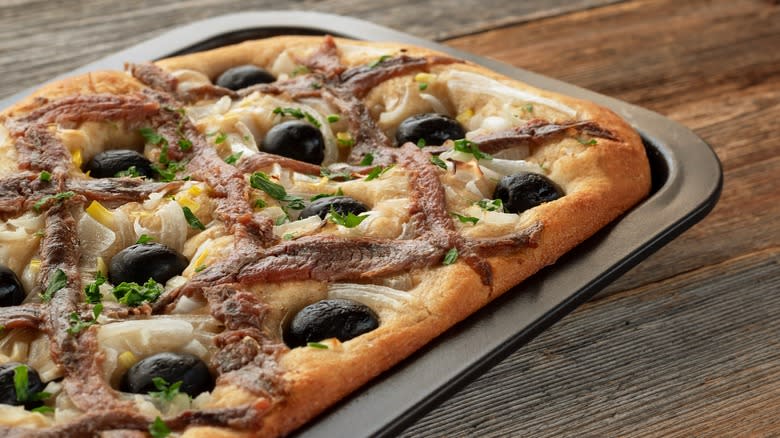
Though they are most commonly found in and known for being amongst the fixings in a Niçoise salad, Niçoise olives are a definitive ingredient in many other traditional dishes from the region of Provence. Pissalidière, an onion flatbread, is a dish that uses Niçoise olives as the crowning topping — the olives are arranged in artful patterns in this Niçoise take on pizza. Niçoise olives are also commonly used to make Stockfisch, a meal of fish cooked with vegetables, that borrows from the olives' savory flavor.
While Niçoise olives are versatile when cooked and work well for most dishes that call for olives, the Niçoise variety is equally well-suited as an hors d'oeuvre and they're just as good eaten by themselves. They have also traditionally been used to make olive tapenade, a spread made of finely-chopped olives, capers, and sometimes anchovies, which is commonly eaten with bread as a popular appetizer across Mediterranean Europe.
Where To Buy Niçoise Olives
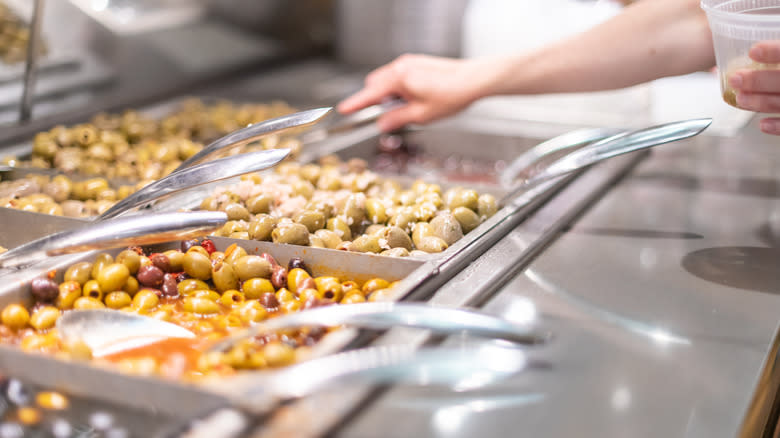
True PDO Niçoise olives are not easy to find outside of Provence or the greater Mediterranean region of the south of France, where these olives are cultivated. But for those who want to taste the truest, most authentic Niçoise olives, they can be ordered online. Roland Foods, a company founded in France in 1934 that has since relocated to the US, is a purveyor of international ingredients that sells un-pitted Niçoise olives online. These olives are also available through other online retailers, marinated in a saltwater brine that is additionally seasoned with thyme.
Olives without the true PDO authentication but prepared in the Niçoise style are more readily available, and can be found in the international grocery section of most supermarkets. They are also available at supermarket olive bars, most notably the savory smorgasbord of ready-to-serve pickled delights at any Whole Foods. Whether or not these olive bar Niçoise olives are authentic, they still offer an idea of the same flavor profile.
Nutritional Information

Niçoise olives, like any variety of olives, contain a considerable amount of salt due to the brine that preserves them, but they are also full of nutrients. Olives in general are high in Vitamin E, an antioxidant that decreases inflammation. Vitamin E is a beneficial nutrient in small doses, but according to the Merck Manual of Diagnosis and Therapy (also known as the MSD Manual), it should be consumed in moderation. Though Vitamin E toxicity is rare, it is a nutrient that may be safer when consumed in a lower concentration than a supplement provides. "Taking too much vitamin E can cause serious side effects," Devon Peart, RD, MHSc, BASc, a registered dietician, told Cleveland Clinic. "It's better to eat vitamin E-rich foods, like olives."
The nutrition label for any given jar of olives may reveal that they're composed mostly of fat, which is why they're such a good base for making oil. Specifically, olives are rich in monounsaturated fat, which the American Heart Association deems as generally beneficial since it's been shown to reduce cholesterol. Olives also contain oleic acid, another "healthy fat" known to be good for heart health. The healthy fats found in olives are why olive oil is considered a healthier oil to cook with, but olives themselves are full of these health benefits too. Eating too many olives delivers a hefty dose of sodium but, when enjoyed in moderation, they're a relatively healthful snack, ingredient, and garnish.
How To Store Niçoise Olives

Once opened, jarred olives last for months in the fridge. Those acquired from the supermarket olive bar, however, will not keep as long. So long as they're submerged in brine, olives from the olive bar should keep for a few weeks; Niçoise olives should always be kept in their brine when being stored, as this keeps them from drying out and helps them to last longer. For the Niçoise olives that come in a jar, there is usually ample brine already to preserve them, but for those procured at the olive bar, it's a good idea to spoon some of the brine in with the olives so that they have a better chance of lasting longer.
It's also fairly easy to make more brine at home if necessary — simply boil salt in water until it dissolves, and add it to olives once it cools. According to the Syndicat Interprofessionnel de l'Olive de Nice, Niçoise olives can be stored either at room temperature or in the lower part of the fridge, but it's generally advised to keep them refrigerated.
Read the original article on Daily Meal.

